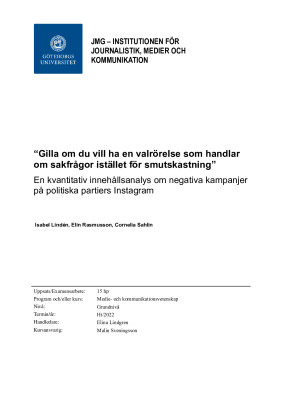“Gilla om du vill ha en valrörelse som handlar om sakfrågor istället för smutskastning”
En kvantitativ innehållsanalys om negativa kampanjer på politiska partiers Instagram
Executive summary
The political strategic communication that involves mapping the opponent’s weaknesses and aiming criticism towards the opponent can be found far back in time. How this criticism has been applied is
something that has varied, but the phenomenon is often referred to as negative campaigning. Negative campaigning is a well studied concept in the US, but despite the fact that the phenomenon also exists in Sweden, it is not yet as researched. Further, political communication via social media platforms, such as Instagram, have become more common throughout the past decade. Despite this, there is a lack of research on political communication on Instagram, including the use of negative campaigning.
Personal attacks have previously been considered to rarely occur during Swedish election campaigns. At the same time, previous research has been able to see an increased affective polarization among voters in Sweden. This gives reason to believe that personal attacks in election campaigns could occur to a greater degree than it previously did. Thus, in addition to researching the extent of negative campaigning in Sweden, it also becomes relevant to examine whether negative campaigns are directed at individual political actors or whether the focus is on political issues.
With a background in previous research, the purpose of this study was to examine and map out the scope and framing of negative campaigning on the parliamentary parties’ Instagram accounts during
the Swedish election campaign in 2022. The time period for the data extends from August 14th, four weeks before the election, to September 11th, the day of the election.
The collected data during the time period includes a total of 590 posts, published by Swedish political parties’ Instagram accounts. Results show that 27 percent of the posts were negative, while 73 percent
of the posts were not negative. Of the 158 posts that were negative, 25 percent were directed at a person, while 87 percent were directed at politics, a post could contain criticism of both a person and politics within the same post. The result also showed that the opposition tends to make more use of negative campaigns than the government. The opposition also tends to use criticism directed at individuals to a greater extent than the government.

